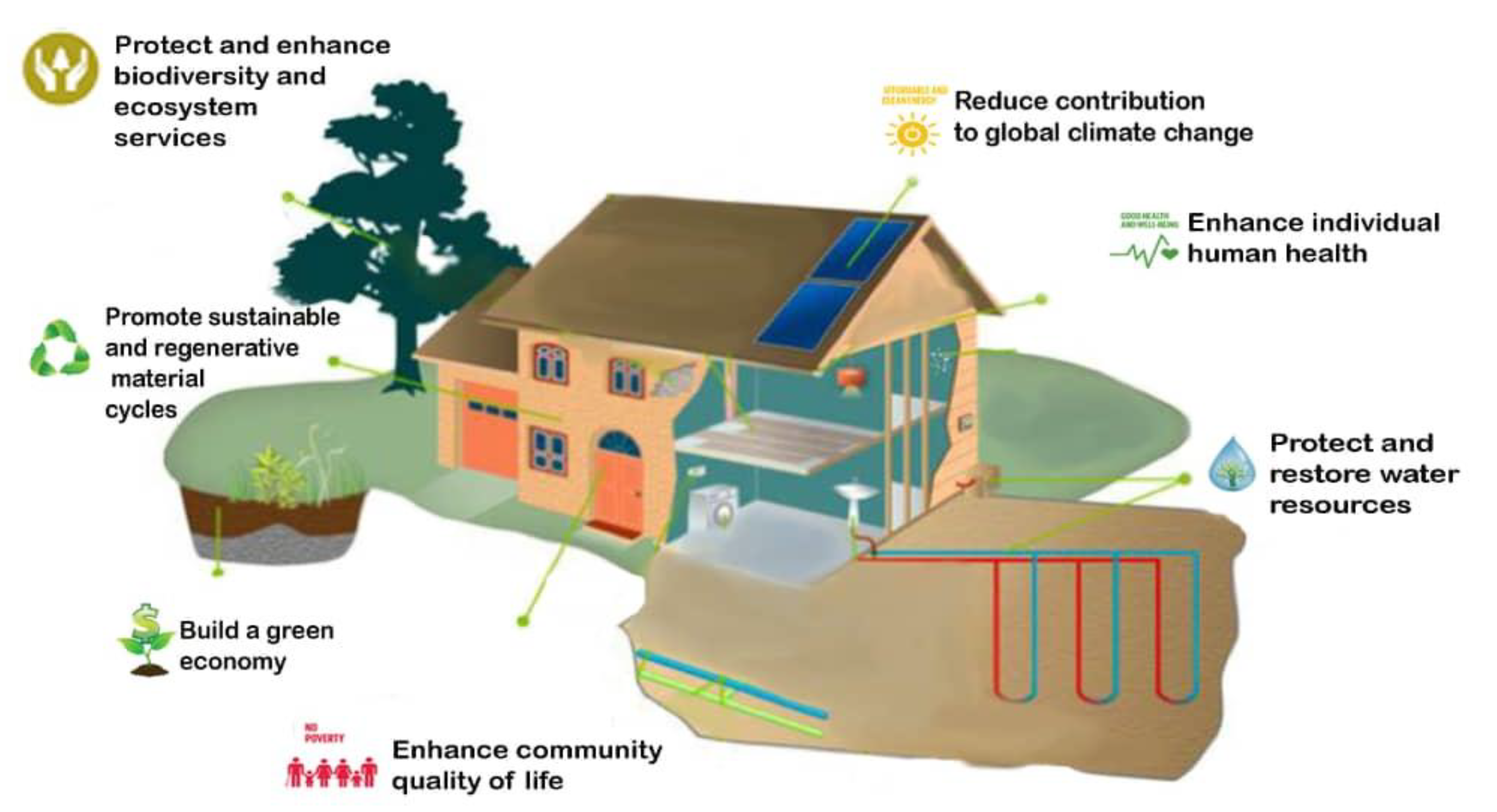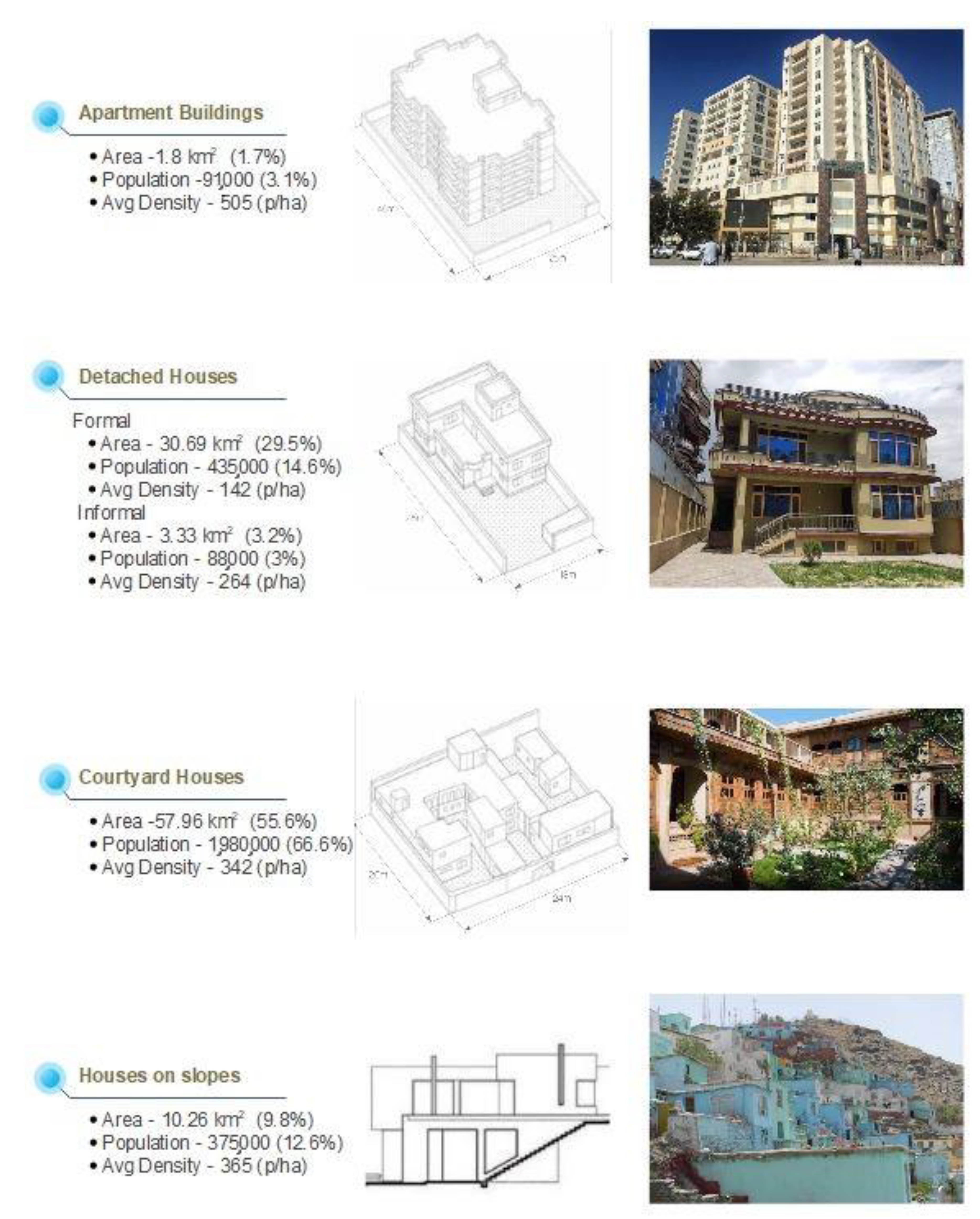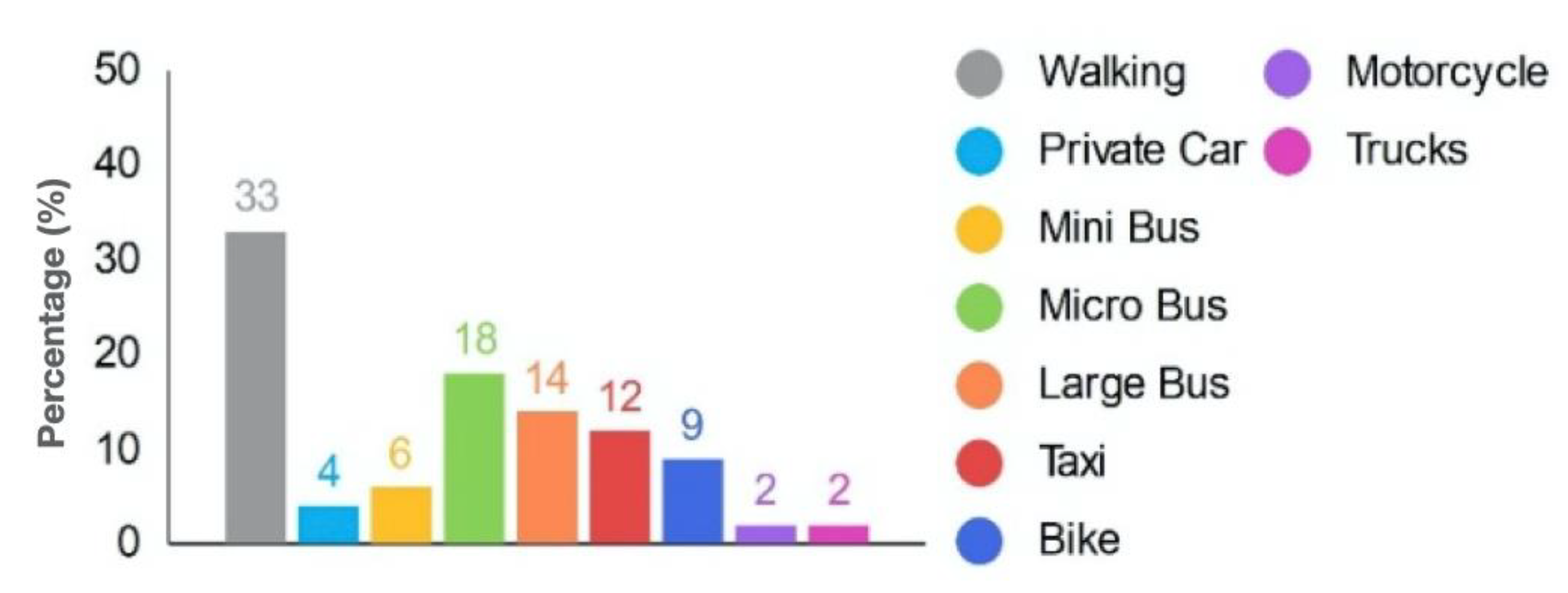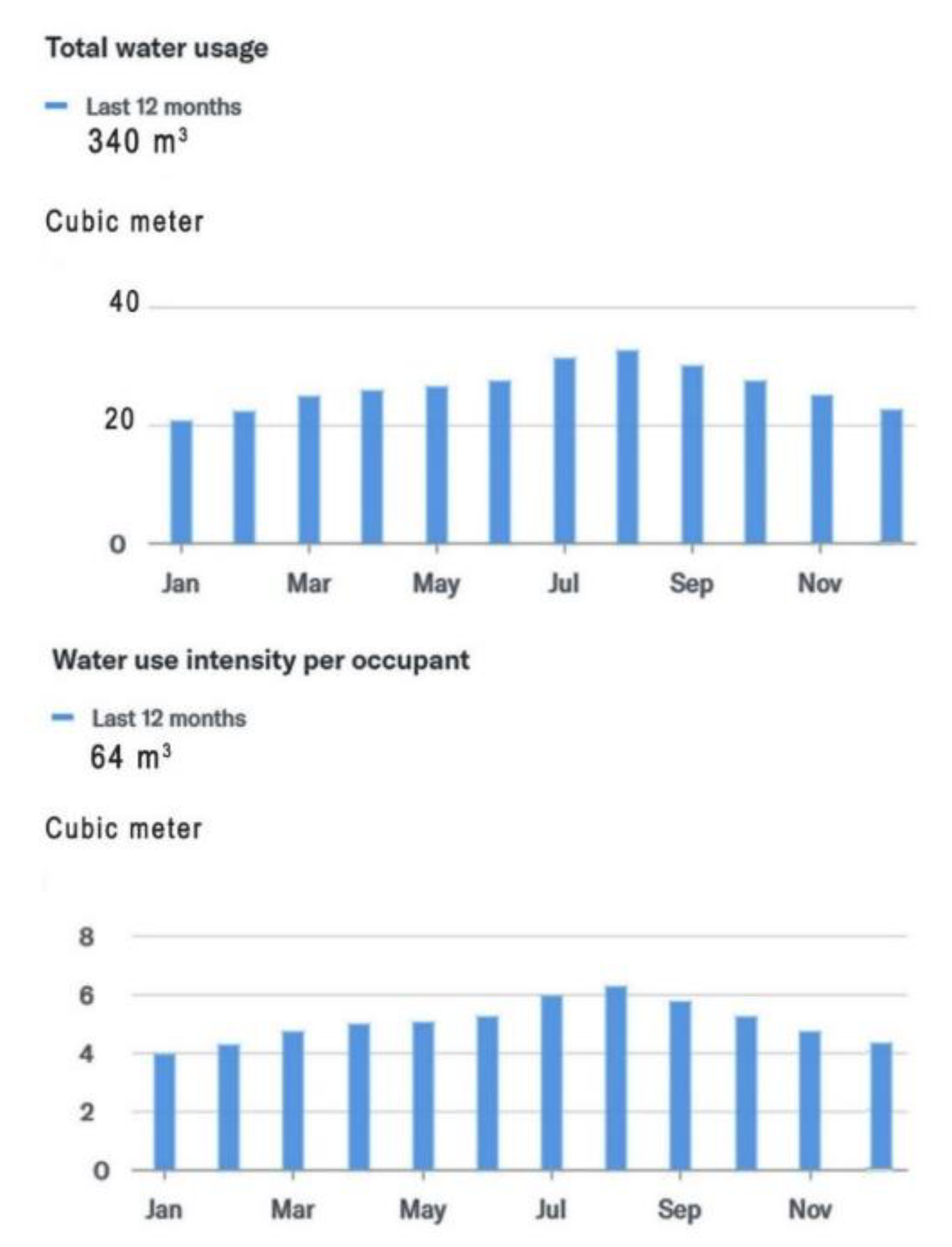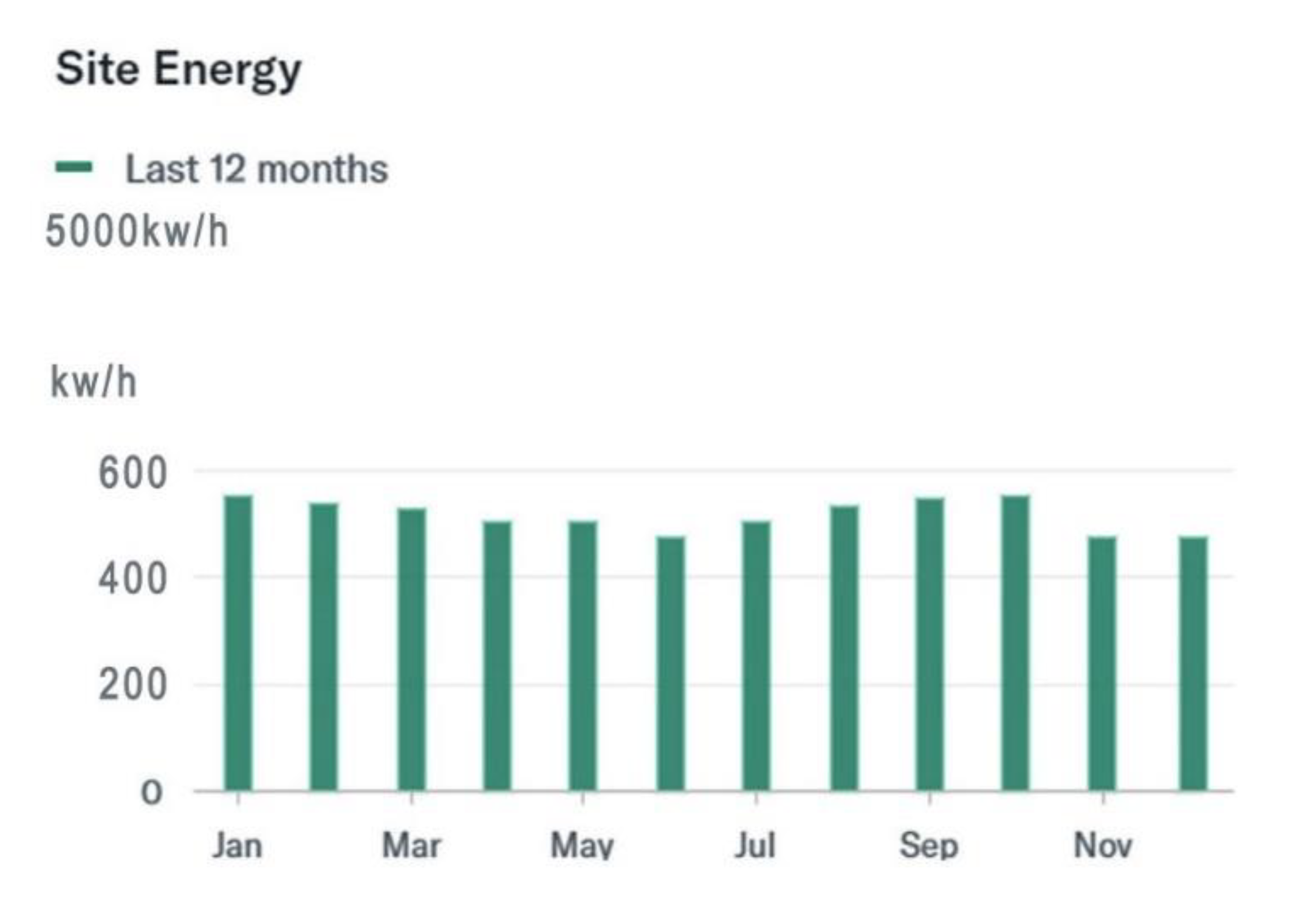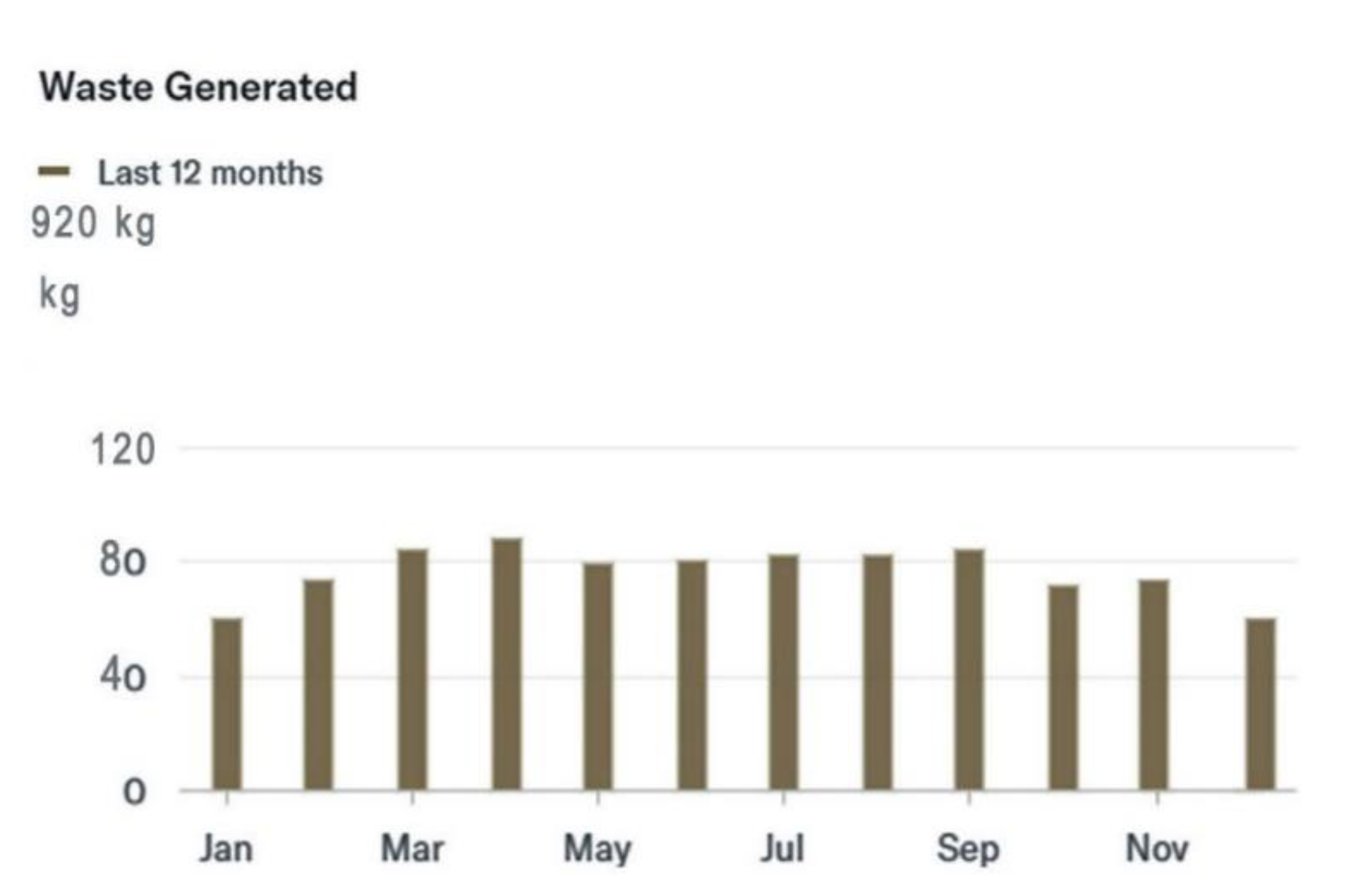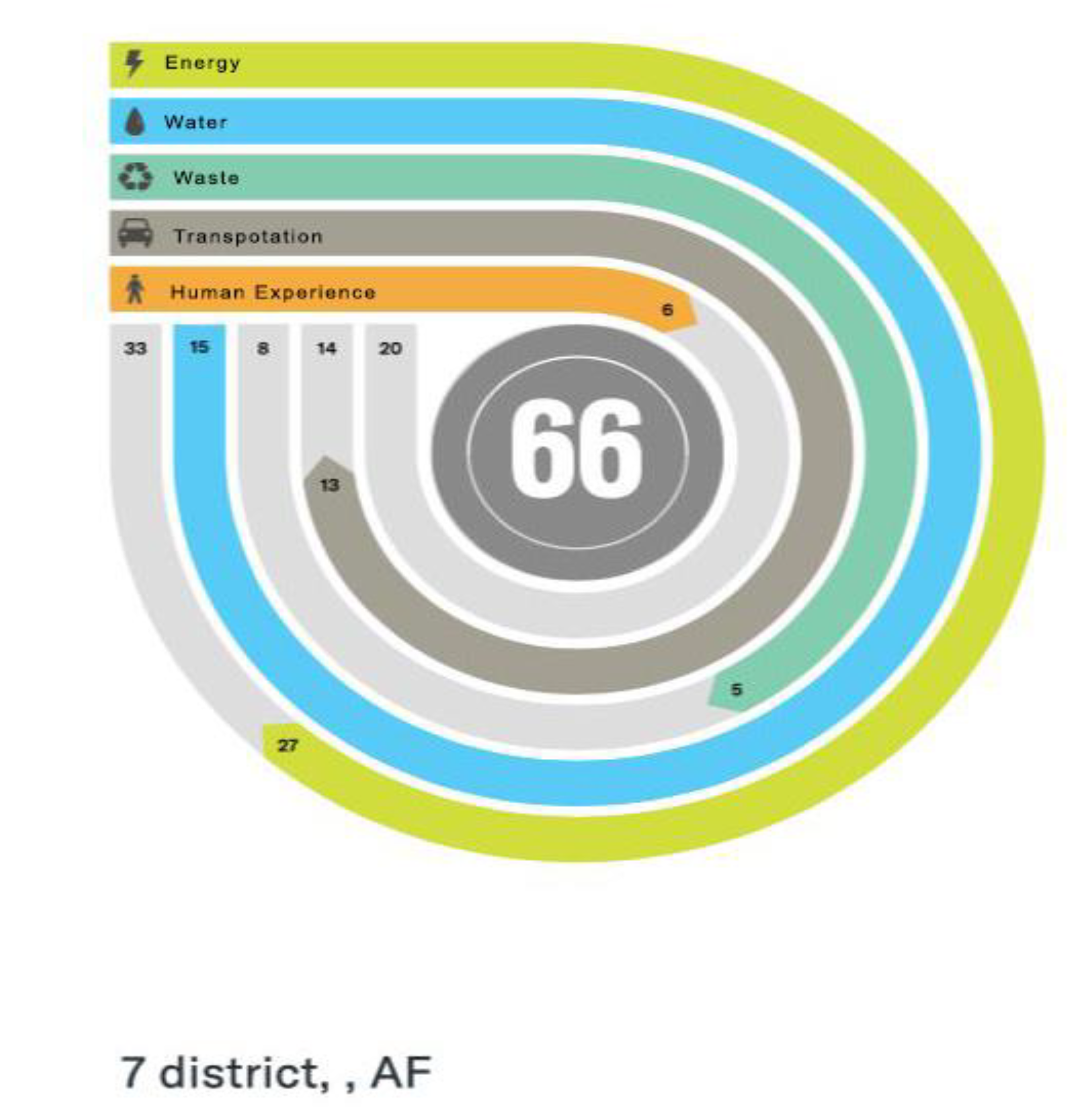1. Introduction
The increase in population, consumption, and depletion of non-renewable resources has impacted the built environment [
1]. These changing conditions increase the need for resource-efficient buildings that consume minimal energy, provide a suitable indoor environment, and are constructed with materials that have long-term value and less waste generation [
2]. Compared to conventionally designed buildings, green buildings offer an impressive reduction in energy and water consumption [
3]. The Green building movement has been international in scope for more than two decades and is currently acknowledged as an international priority in several countries worldwide [
2]. There are around 70 countries that either have or establish green building councils, which require a strict assessment system [
3]. In addition, to improve the environmental performance of buildings, some countries and institutions have introduced mandatory building codes and standards.
Moreover, the advent of several assessment systems across the globe shows an apparent effort being invested in the definition of the Green building concept and evaluation of its performance [
4]. Being a criteria-based assessment tool, the Leadership in Energy and Environmental Design (LEED) aims to build performance improvements based on various factors, including water consumption, energy performance, environmental impact, and indoor quality [
5].
The increasing population in Kabul is clear evidence of the high demand for residential buildings, which account for the vast majority of building stock. However, high environmental impacts and intense consumption of energy resources in residential buildings of Kabul city must be alarmed as a national security concern, trigger a sustainable movement and implementation of green practices. Hence, this study aims to assess the LEED rating of residential buildings stocks in Kabul city, identify the weaknesses areas from LEED perspective, and finally suggest specific modifications to upgrade them to more sustainable ones.
2. Literature Review
2.1. Building Sustainability Rating Systems
The sustainable built environment concept gained significant attention from the scientific community due to the tremendous increase in greenhouse gas emissions generated by the exploitation of natural resources [
6]. Some studies state that buildings worldwide use a considerable amount of world resources. Buildings account for about 17% of water usage, 33% of carbon gas emission, 40% of material usage, and 25% of wood usage. In Afghanistan, buildings account for about 93% of all electrical energy and a significant share of greenhouse gas emissions [
7]. Poorly designed and constructed buildings use more energy-intensive, increasing the demand for energy production and contributing to global warming [
8]. The energy use and associated emissions from buildings can increase two or possibly threefolds until 2050 due to several key trends, including growth in population, relocation to urban areas, changes in family size, and behavioral changes [
9]. This issue reveals the need for radical changes in the built environment. Changing the conventional building construction and retrofitting into a greener one is an indispensable step to ensure a sustainable built environment [
10]. Green buildings save natural resources and contribute to the occupant’s health and comfort through temperature and humidity control, indoor air quality, natural lighting, and waste management. Therefore, green building rating systems like LEED, BREEM, Green Globes, MATOOL, and many others are established to balance these issues using integrated ways to reach design solutions [
11]. They are providing frameworks with precise criteria for assessing the various aspects of a building’s environmental impact [
12].
2.2. LEED Rating System
LEED (Leadership in Energy and Environmental Design) is a voluntary, consensus-based international-standard for developing high-performance, sustainable buildings [
13]. The system is categorized into seven primary areas: Transportation performance, Site sustainability, Water performance, Energy and Atmosphere, Material and Resources, Indoor environmental quality, and Innovation [
14].
Figure 1 describes LEED V4.1 certification factors for existing buildings.
The LEED rating system recognizes buildings that meet high standards in durability, health, reduced environmental impact, and energy efficiency. It works throughout the building lifecycle –while the green-building design, construction, operations, and maintenance are paramount. Waste management plays an essential role in LEED certification, focusing on reusing, recycling, and diverting construction, demolition, and land-clearing debris from disposal in landfills and incinerators [
15]. LEED provides a point system to score green building design and construction. In addition, some prerequisite credits are mandatory for any level of LEED certification. The more points awarded, the higher the level of certification achieved from Certified, Silver, Gold, to Platinum [
16]. To be certified, the building project needs to obtain specific points and meet green building standards. Receiving a certification from LEED demonstrates that a building is an environmentally responsible and a healthy place to live and work. It will reduce the building operation and maintenance costs while promoting a great working and indoor environment for all building users. LEED-certified buildings, on average, are saving 25 to 30% of energy compared to conventional buildings [
17].
Figure 2 illustrates LEED system goals in buildings. This research uses LEED V4.1 for existing buildings, which applies to single-family homes, low-rise multi-family (1–3 stories), or mid-rise multi-family (4–6 stories) to assess Kabul residential buildings.
2.3. Kabul Residential Buildings
Kabul city, the capital of Afghanistan, is one of those fastest-growing cities, where its population growth is faster than its economic growth. Its conflict-ridden past and the rapid current growth in both income and population pose unique challenges for the housing in Kabul city; nearly two-thirds of the housing stock has been damaged or destroyed during the last three decades of war [
18]. After the wars, significant waves of migrants and rapid unplanned expansion have made it one of the most informally developed cities in the region. The urban sprawl and lack of capacity within the government to provide affordable houses have led the inhabitants to shape their living spaces by responding to the housing needs of the growing population [
19]. As a result, informal settlements are overcrowded, providing shelter for around 80% of Kabul’s population and covering 69% of Kabul’s residential land, including 10,000 people living in tents and 5000 living in destroyed buildings [
20]. The development of illegal and overcrowded housing without access to essential city services has been another challenge for urban planners. Based on the researcher’s investigation, it is the only capital city in the world that does not have essential urban services such as water and sewage systems, gas and heat distribution, and public transportation, with inferior waste management and almost no control system on the winterization of residential houses [
21].
2.3.1. A Historical Perspective
The residential buildings in Kabul are historically classified according to the periods in which they were built. Since Kabul has a history of 3500 years, it experienced different typologies of housing. The original birthplace of Kabul City was Khurd Kabul which has a small distance to the east of present Kabul city [
22]. Typically, the houses were one story high, mud brick or mud (pakhsa), flat roof, walled, and very congested, shaped according to the distinct needs of social and cultural requirements [
23]. Until the beginning of the 20th century, Kabul was still a compact city. In the 1920s, new neighborhoods such as Shahr-e-naw were built, motivated by European architecture and planning concepts. As a result, the villa concept translated into a house in the middle of the lot, which was then surrounded by a privacy compound wall, became a popular model [
24]. As Kabul became attractive in the 60s and 70s, many people moved in from other cities and villages to live in Kabul. Kabul was attractive for two reasons, economy and standard of living. There were job opportunities for everyone, and there was a relatively better standard of living with almost four distinct seasons and convenient environmental temperature and pleasure in Kabul [
24]. The rapid expansion of the city created the necessity of a strategic plan development.
The master plan was planned for four large zones; The northwest zone (Polecharkhi and Qala-e-Zaman Khan), northeast zone (Khair Khana and Karte Parwan areas), southwest zone (Darul Aman, Karte 4, Karte 3, Khoshaal khan), and southeast zone (Karte Naw and Shah Shahid areas) [
24]. Nevertheless, the wars in the 80s and 90s disturbed the growth pattern and brought up many unfortunates that left Kabul as a ghost city. Sixty-percent of infrastructure and 63,000 houses have been destroyed during the last three decades of war [
22]. After the wars, most of the refugees returned, causing a spectacular increase in population which caused the city to grow in every direction without any prior planning. Many illegal and overcrowded housing is developed without access to essential city services [
23].
Figure 3 illustrates the historical development of residential areas in Kabul city.
2.3.2. Housing Typologies
In Kabul, many types of households exist, but the most common ones are courtyard houses, detached houses, apartment buildings, and houses on mountain slopes [
17].
Courtyard Houses
This is a type of house where the central part of the building is disposed around the central courtyard. The primary concern in this type of housing is privacy and security; therefore, one could hardly see openings or windows open to the streets or alleys, and it received its light from the inner courtyard. Looking from the courtyard, the facades are wooden module panels that were used as a dimensional unit all over the house. Courtyards and row houses are excellent housing prototypes for practical quality of living. The typical wall construction can conserve up to 50% of the energy and maintenance costs of a single, detached house [
24]. Courtyard houses proved to be excellent examples of employing passive cooling strategies, played a conscious role in the moderation of the climate in hot summer seasons, and provided comfortable living conditions for the families [
25]. Houses are provided with an elaborate under the floor heating system, Tawakhana (Tawakhana (تاوه خانه): A tradition floor heating system. The heat source is exhausted from a clay oven; Tandor, located in the kitchen. While cooking, the auxiliary heat is circulated through continuous heating tunnels constructed under the room floor. When the worm air reaches the end of the circulation tunnels, it escape through an outlet located on the opposite wall). Roofs are usually used for daily activities, recreation, and sleep in summer.
Detached Houses
This is the most common form of housing in the formal sector. They are built at one side of the plot and leaving the center of the plot as an open courtyard. The pattern of these housing development was based on simple gridiron layouts and rectangular lot divisions of various sizes ranging from 200–400 m
2 [
26]. Typically, two-story house plans, European style, were enforced to be built in these lots. Traditionally people build walls, 2-m high on property lines to enclose their lots. In addition, authorities enforced a minimum of the 1-m side set-back requirement for the house’s location from the property line.
Apartment Buildings
The most common type of housing currently being built by private developers is apartments. These are typically two- or three-bedroom units, approximately 100–120 m
2 in area, in five–six story buildings. The government mainly built these building types in the past, e.g., Makrorayan, but currently they are mainly constructed by the private sector [
27].
Houses on Mountain Slopes
The houses and the land in this area do not have any legal title. Lots are irregular in shape and of different sizes. The old houses in this area are of the usual traditional type built from adobe and mud. In the new houses, they took advantage of brick and stone. Houses on the lower part of the hill are two-story apartment-like structures overlooking the circulation paths. As one goes higher, the house becomes detached and spread out. There are no sanitary services or water in this area. The water is carried by the users or by water carriers (saque (Saque: Persons get paid for carrying water to homes)) from the foot of the hill, where public water pipeline is provided. There are no defined open spaces on the site. There is no other regular circulation pattern in the locality, and almost all the circulation is predominantly pedestrian. The pedestrian paths are heavily influenced by topography, and muddy walkways, making walking difficult during the winter. The sidewalks are narrow and have little sunshine, which provides frost problems in winter. Also, the big problem here is garbage which is thrown in open areas and walkways. The absence of sewage management, especially in these areas, is a significant environmental and residence problem.
Figure 4 illustrates different residential buildings typologies in Kabul city.
3. Methodology
This paper presents the existing Kabul city residential buildings conformity to the LEED rating system. Based on the literature review, by examining the green building aspects and LEED criteria and examining the residential sector in Kabul city, a five-stage methodology, as illustrated in
Figure 5, has been implemented to conduct this research.
Firstly, the characterization/taxonomy of residential building types was completed by categorizing them into several groups. This classification was based on investigations as well as available official records. This step of the research helps the authors to study specific aspects of buildings, and also the building owners learn what elements in their buildings needs upgrade. Subsequently, the building rating systems in general and LEED certification criteria in specific were briefly described. This step of the study help the authors and the readers know what aspects are considered in order to rate a building from energy and environment perspectives. As the first LEED silver rated building in Kabul city, the World-Bank building utilized for residential and banking use, was selected as a case study. This building could be also considered a bench-mark for the buildings studied in this research. Considering the LEED v4.1 for Operation and Maintenance, existing buildings checklist was adopted to track the identified LEED criteria in existing residential buildings. This checklist collects information in seven categories (See
Figure 6).
The actual study of buildings is conducted by online and offline methods. Data concerning buildings setting, waste stream, electricity metering, water metering, indoor air quality satisfaction, transportation modes, and distance traveled by occupants were gathered through an online questionnaire (Around 100 responses received through the online data collection) and uploaded to the
https://arcskoru.com/ (12 March 2021) website, where all measurements were assessed, and the LEED score was obtained for Kabul city residential buildings. However, sustainable sites and Innovation categories are not available on the Arcskoru website and are calculated manually for each project (See
Figure 7 for the LEED scorecard adopted for this study). The average of all the responses in each category was calculated. This method primarily focuses on the quantitative data and measurements of each building without considering the prerequisites. So, one could not rely entirely upon. Therefore, it was decided to conduct a secondary assessment of buildings by developing a scorecard based on LEED criteria and assess the four most common building types existing in Kabul, namely courtyard houses, detached houses, apartment buildings, and houses built on mountain slopes.
The secondary assessment is mainly based on field assessments and investigations and previous studies. Forty buildings in total, ten from every four categories, are surveyed in total. First, the findings of the physically surveyed buildings are aggregated and analyzed. After comparing online and offline survey findings, the research results are presented in the analysis and discussion sections. The discussion section presents both pros and cons of each type of the buildings studied from each seven categories of LEED certification perspective. Lastly, specific recommendation for the stakeholders of the building sector in Afghanistan is provided in order to make residential buildings more environmentally friendly and energy-efficient. Recommendations are provided specifically for each building type in every seven areas of LEED certification system.
4. Case Study-World Bank Group Office Building
World Bank Group Office Building at Kabul is the building of residential and banking use which has been planned in such a manner that it integrates green and sustainable measures right from the conceptual stage to ensure that the building meets the various green goals while also ensuring that it is a healthy and comfortable space for all its occupants. The project pursued a LEED BD+C NC v2009 rating from U.S. Green Building Council (USGBC) and achieved the Silver rating in line with LEED requirements. The project achieved 16 points on sustainable sites, 10 points on water efficiency, 9 points on energy and atmosphere, 5 points on material and resources, 7 points on indoor environmental quality, 6 points in Innovation and design, and 4 points on regional priority category a total of 57 points which goes to silver certification. World Bank Group Office building has met all the prerequisites and credits in the LEED rating system. The project has provided mechanical STP to treat 100% of the wastewater generated on-site using a sewage treatment plant to tertiary standards meaning water worthy for reuse in landscaping, air conditioning, toilet flushing and other non-potable water use. It has identified storage and collection of recyclables (Trash Compactor) area of about 22 m
2, covered 50% of the parking areas with solar panels, and provided a landscape area of around 828.8 m
2 (416.94 m
2 on ground + 411.89 m
2 on the roof) [
28].
Figure 8 presents a layout of the building.
5. Results and Analysis
5.1. Scoring by USGBC Website
As described in the methodology, to find the LEED score for each residential building, we need to input data gathered from the survey to the USGBC website and score online. The results are provided below.
5.1.1. Location and Transportation
The transportation performance score rates the project’s greenhouse gas emissions measured in carbon dioxide equivalent emissions (CO2e) resulting from transportation to and from the building against other high-performing buildings worldwide. The number of routes for two-way commutes over one week per route of the commuting transportation mode(s) and distance traveled (in miles or kilometers) by all regular building occupants is required to calculate a transportation performance score [
30]. Once the required data is obtained via the online survey, it is further verified through the transportation survey conducted via the “arcskoru” website to assess occupants’ transport patterns and visitors’ CO2e pounds/mile consumption rates.
In Kabul city, the primary transport infrastructure is not sufficiently built. Traffic congestion affects the movement of the city’s inhabitants and directly affects the residents’ health, and causes environmental issues. The leading causes of transport problems are the lack of public transport. Intersections are not built multilevel, and traffic regulations are not observed. Due to the lack of bus stops and taxi stands, the drivers halt their vehicles at no parking spots, which cause more congestion; vendors have further worsened the road traffic situation. Kabul ranks among the most polluted capital cities, and traffic congestion is one of the main contributors to air pollution. Most of the vehicles are old, and fuel quality is poor. Due to the lack of traffic rules and the heavy traffic, it takes much longer to reach a destination. The amount of generated CO2 could not be accurately measured by calculating the distance traveled and transportation mode used according to LEED guidance, since the heavy traffic and low-quality fuel used by vehicles play a significant role. Therefore, the transportation performance is scored based on available records in KUDF, reports, and papers related to Kabul city’s transportation sector.
The total fuel consumed by all vehicles in Kabul city is 2,306,481 m
3/year (911,542 m
3/year petrol and 1,394,939 m
3/year diesel shares). Consequently, the amount of pollution which is emitted from burning these fuel-based resources is 2,180,408 ton/year CO
2, 46 ton/year NO
X, 529 kg/year SO
X from the total amount of petrol consumption, and 3,431,550 ton/year CO
2, 642 kg/year from diesel consumption [
20].
Figure 9 shows the transportation mode popularity in Kabul city.
5.1.2. Sustainable Sites
The sustainable site’s checklist was not available on the website and needed to be separately calculated for each project.
Rainwater Management
Most of Kabul’s houses do not have any means to collect and reuse water on-site. However, buildings with vegetated land-piece in their open courts and back gardens have achieved one point in rainwater management credit.
Heat Island Reduction
None of the surveyed buildings owned a vegetated roof, while buildings with high reflectance roofs achieved one credit. According to the houses surveyed, the roofs of most courtyard and houses build on slopes are mainly made of wood beams and mud (Kahgel (Kahgel: It is an old material which has been used at the top roofs and walls as their finishing layers. Mud Plaster (kahgel) is an admixture of straw and mud with a specific percentage of each ingredient. Straw increases adhesiveness of mud and length of each straw should not be less than 10 cm [
31]). The thermal conductivity of these roofs are around 0.9 W/mK. The apartments’ roofs are mostly made of concrete and further isolated by Isogam (Isogam is a layer heat and water insulation) sheating. According to [
32] the thermal conductivity of isogam is 0.12–0.23 W/mK. It is worth mentioning that there are number of houses with galvanized-metal pitch-roofs, with a Solar Reflectance Index of around 42 and thermal conductivity of 0.05 W/mK. As a rule of thumb, the higher the Solar Reflectance Index, the cooler the material. Thus, the pitch roofs are the best for heat island reduction.
All the buildings lacked Light Pollution Reduction because exterior features are not shielded, and the site management credit point was absent.
5.1.3. Water Performance
To calculate the water performance score for buildings, the total potable water monthly usage was measured for twelve consecutive months (one full year). The water consumption ranged between 20 m
3–35 m
3 per month. Received data was inserted within the water scoring functions to find out the water performance score.
Figure 10 shows an average of the water usage by Kabul residents from the buildings surveyed.
5.1.4. Energy and Atmosphere
According to Afghan National Standardization Authority (ANSA) which has introduced Afghanistan Energy Efficiency Code for Building, 93% of all electrical energy in Afghanistan is used by the building. Furthermore, the average use of electrical energy in a residential building is 1856 kWh/year (18% for lighting, 17% for refrigeration, 11% for cooking, 9.8% for ironing, 9.4% for cooking, 8.8% for vacuum cleaning, 5.9% for heating, 3.93% T.V., 3.6% for the electronic appliance, 3.07% for washing machine, and 1.8% for water pumping). Therefore, if this energy is used efficiently, the building energy use can be reduced by 50% [
8].
To calculate the buildings’ energy performance score, monthly energy use (Including all energy sources used in the building, e.g., electricity, gas, on-site renewable energy, etc.) for twelve consecutive months has been sought.
Figure 11 illustrates the average electricity usage by occupants in residential buildings surveyed.
Fundamental Refrigerant Management: In Afghanistan most of the equipment used are of low quality, so they still use chlorofluorocarbon (CFC)-based refrigerants and lack the prerequisite Fundamental Refrigerant Management.
Enhanced Refrigerant Management: those buildings in which refrigerant is not used has achieved this point. The projects lacked grid harmonization credit.
5.1.5. Material and Resources
Purchasing Policy
The houses surveyed do not have in place an environmentally preferable purchasing (EPP) policy for materials and products (Consumables, Electronic Equipment), and most of the material which is imported to Afghanistan are of low quality so the buildings lack purchasing policy prerequisite. Although the buildings lacked purchasing policy and Facility maintenance and renovation policy prerequisite credits, the waste performance score was granted.
Purchasing: In most of the residential buildings surveyed, paper and wood products are not certified, Bio-based products do not meet the standard, and the batteries are not rechargeable. Therefore, most of the buildings surveyed lack the Purchasing credit.
5.1.6. Indoor Environmental Quality
In 90% of the buildings surveyed, Tobacco Smoke is prohibited, so they meet the Environmental Tobacco Smoke Control prerequisite.
The buildings in Kabul city do not meet the green cleaning policy prerequisite because cleaning products and materials do not meet the green-cleaning criteria.
Indoor Environmental quality performance: To assess LEED Points for Human Experience, these three components need to be measured:
According to the survey, most of the houses burn coal or wood during the winter to heat the indoor spaces, and the smoke from biomass affects indoor air quality and exacerbates the outdoor pollution during the winter. Some hazardous compounds such as benzene, acetaldehyde, hydrogen chloride, and dioxins in the air were from burning coal and wood. So, these buildings lack 50% (10 points) of the score from CO
2 and TVOC measurements. Consequently, more than 50% of occupants were unsatisfied with their indoor air quality, so the buildings could not achieve any credit from this category. The occupant comfort survey for the buildings surveyed is shown in
Figure 13.
All the residential buildings which are surveyed lacked 2 points of green cleaning policy and integrated pest management for indoor environmental quality. Since there were no integrated pest management plans for the buildings and grounds within the project boundary, the cleaning products and materials do not meet the standards.
5.1.7. Innovation
In the traditional buildings of Kabul city, houses are provided with elaborate under the floor heating systems, Tawakhana, and the use of wind catchers, Badgir (maximizes additional air circulation into the interior rooms and provides natural cross ventilation), which can increase points in the innovation category. However, contemporary buildings lack innovation credit; therefore, the buildings achieved no credit points in innovation.
The link to the survey data is provided below:
Note: The scores in this table are based on only the measurements of the survey, not considering requirements and prerequisites. It shows that if buildings are upgraded to meet the prerequisites, most of them can qualify for LEED certification candidacy. For example, the measurements of a building in Qala E Ghaibi turns out the graphs shown in
Figure 14.
According
Figure 15 that summarizes the results of “arcskoru” website, the house gets a pretty high score of LEED. However, the average LEED score for the surveyed buildings is 37, which does not qualify buildings for LEED certification.
5.2. LEED Score by Field Survey
Since all the results presented by the “
www.arcskoru.com” (accessed on 30 March 2021) LEED scoring system are based on quantitative data, not considering the prerequisites and minimum LEED certification requirements a scorecard has been prepared according to LEED, and all four types of Kabul city buildings are scored according to this scorecard. In this part, the result of field visits of around 40 buildings has been presented. From the 40 residential buildings surveyed, 10 of each of the four types are included from different locations in Kabul city. The average of the LEED scores for each type of building is summarized in
Table 1.
According to table, Courtyard houses get the highest score and houses on the mountain slopes gets the lowest of all. The average LEED score for all types of residential building in Kabul city is measured to be 20. None of the buildings are even close to the lowest LEED certification category.
6. Discussion
Most of the developments in the building sector of Kabul city happened between the years 1978–2020. The building industry development from 1978–2001 was almost planned and based on the Kabul city master plan. However, the boom in the building sector and city expansion after 2001 has been almost unplanned and fast. This unplanned and uncontrolled building industry development resulted in accumulation of low-quality buildings in Kabul city. Neither city authorities nor building owners observed environmental and sustainability considerations while constructing buildings. Low technical capacity of the urban sector, low awareness of building owners, lack of applicable building codes and standards, lack of city master plan, corruption, and the weak rule of law can be listed as key factors of the challenges of the building sector in Kabul city.
According to the findings of this study, there are certain pros and cons associated with each type of the buildings. These pros and cons are summarized in
Table 2 and
Table 3, respectively.
7. Recommendations
In order to help improve the quality of residential buildings from sustainability perspective, a coordinated and integrative approach of stakeholders of Afghanistan building sector is crucial. First and foremost, the policy-making tier has the first call to make. Introducing, setting, and monitoring national targets for an enhanced environment of cities is critical for every other step to be taken. Consequently, the development of laws, policies, regulations, codes and standards for the building industry would be the prerequisite for the urban planning, where buildings are a major factor. Currently, lack of a responsive legal and regulatory framework for the building sector of Afghanistan is the leading cause of unsustainable buildings in Kabul city, and all over Afghanistan [
33].
Another important issue is the role-overlap, lack of coordination, and poor cooperation of government entities responsible for urban matters. It is suggested that the roles of each involved entity is defined.
However, there are some steps that can be taken by local authorities, building owners and residents that could help buildings transformed to be more sustainable and environmentally friendly.
Table 4 describes some specific recommendations, based on the findings of this study.
8. Conclusions
In this research, existing residential buildings in Kabul city are rated according to LEED. Based on the measurements and calculations, it is revealed that the informal settlements, that cover one-third of Kabul’s residential buildings, do not meet the minimum requirements of the LEED certification system. Most formal settlements also lack the prerequisites and minimum requirements to be candidates for LEED certification. They are in poor condition and are in desperate need of an upgrade. Specific recommendations for improving efficiencies and energy consumption have been proposed for each LEED primary areas.
This is the first study of its kind conducted for Kabul city residential building. Considering the cross sectoral aspect of buildings industry, the findings of this study will contribute to many other areas such as water, transportation, ICT, health, energy, and the environment.
This study could be further improved by adding to the survey population, incorporating more accurate and verified data, and applying new and innovative approaches to collect better and analyze buildings data. In addition, this study could be extended to commercial, mixed-use, governmental, and industrial buildings. As other major consumers of the energy, industrial and governmental buildings study will help urban sector entities take more robust environmental protection measures and efficient energy consumption.
Author Contributions
Conceptualization, N.R.S. and T.S.; methodology, N.R.S., T.S. and A.H.M.; software, H.W., N.S., R.M. and F.R.; validation, N.R.S. and A.H.M.; formal analysis, H.W., N.S., R.M. and F.R.; investigation, H.W., N.S., R.M. and F.R.; resources, H.W., N.S., R.M. and F.R.; data curation, A.H.M., H.W., N.S., R.M. and F.R.; writing—original draft preparation, N.R.S. and H.W.; writing—review and editing, N.R.S. and T.S. and H.W.; visualization, H.W., N.S., R.M. and F.R.; supervision, N.R.S., T.S. and A.H.M. All authors have read and agreed to the published version of the manuscript.
Funding
This research received no external funding.
Institutional Review Board Statement
Not applicable.
Informed Consent Statement
Not applicable.
Data Availability Statement
Conflicts of Interest
The authors declare no conflict of interest.
References
- Emami, N.; Marteinsson, B.; Heinonen, J. Environmental Impact Assessment of a School Building in Iceland Using LCA-Including the Effect of Long Distance Transport of Materials. Buildings 2016, 6, 46. [Google Scholar] [CrossRef]
- Akadiri, P.O.; Chinyio, E.A.; Olomolaiye, P.O. Design of A Sustainable Building: A Conceptual Framework for Implementing Sustainability in the Building Sector. Buildings 2012, 2, 126–152. [Google Scholar] [CrossRef]
- Akbarnezhad, A.; Xiao, J. Estimation and Minimization of Embodied Carbon of Buildings: A Review. Buildings 2017, 7, 5. [Google Scholar] [CrossRef]
- ElSorady, D.A.; Rizk, S.M. LEED v4.1 operations & maintenance for existing buildings and compliance assessment: Bayt Al-Suhaymi, Historic Cairo. Alex. Eng. J. 2020, 59, 519–531. [Google Scholar] [CrossRef]
- Ali, H.H.; Al Nsairat, S.F. Developing a green building assessment tool for developing countries—Case of Jordan. Build. Environ. 2009, 44, 1053–1064. [Google Scholar] [CrossRef]
- Hall, M.S.E.B.; Leventhal, S. What Is LEED? 2021. Available online: https://briburn.com/learn/what-is-leed-certification/ (accessed on 18 December 2020).
- Harvard University Campus Services. Leed Platinum Leed ® Facts Leed-Eb Project Team. 2012. Available online: https://www.energyandfacilities.harvard.edu/sites/default/files/CS Blackstone EB-Case Study.pdf (accessed on 31 March 2021).
- Afghan National Standards Authority (ANAS). Afghanistan Energy Efficiency Code for Building. 2015. Available online: http://energyefficiency.gov.np/uploads/1_11_zabiullah__1449805762.pdf (accessed on 30 March 2021).
- Directorate-General for Research and Innovation. Final Report of the High-Level Panel of the European Decarbonisation Pathways Initiative; Publications Office of the EU: Luxembourg, 2018. [Google Scholar] [CrossRef]
- Karakhan, A.A. LEED-Certified Projects: Green or Sustainable? J. Manag. Eng. 2016, 32, 02516001. [Google Scholar] [CrossRef]
- Iulian, F.G. MATOOL solution in evaluating smart buildings. Int. J. Electr. Eng. Comput. Sci. 2019, 1, 19–23. [Google Scholar]
- Kats, G.; Alevantis, L.; Berman, A.; Mills, E.; Perlman, J. The Costs and Financial Benefits of Green Buildings A Report to California’s Sustainable Building Task Force. Building 2003. Available online: http://www.usgbc.org/sites/default/files/costsofgreen_0.pdf (accessed on 30 March 2021).
- US Green Building Council (USGBC). LEED v4.1: Residential BD+C Multifamily Homes; USGBC: Washington, DC, USA, 2020. [Google Scholar]
- US Green Building Council (USGBC). Leed v4.1 Building Design and Construction; USGBC: Washington, DC, USA, 2020. [Google Scholar]
- US Green Building Council (USGBC). Leed v4.1 Operations and Maintenance; USGBC: Washington, DC, USA, 2019. [Google Scholar]
- US Green Building Council (USGBC). Leed v4.1 Residential Single Family Homes; USGBC: Washington, DC, USA, 2020. [Google Scholar]
- Bertaud, A. Kabul Urban Development Current City Structure, Spatial Issues, Recommendations on Urban Planning; The World Bank: Kabul, Afghanistan, 2005; pp. 1–31. [Google Scholar]
- Ahmadzai, A. Traffic and Transportation in Kabul City—Proposed solutions. Kardan J. Eng. Technol. 2019, 1, 69–81. [Google Scholar]
- Kazimee, B.A. Sustainable reconstruction and planning strategies for Afghan cities: Conservation in cultural and environmental heritage. WIT Trans. Ecol. Environ. 2006, 93, 49–59. [Google Scholar] [CrossRef]
- Rahmaty, H.; Ershad, A.M.; Sabory, N.R. Afghanistan fuel market prediction. Repa Proc. Ser. 2020, 1, 1–12. [Google Scholar] [CrossRef]
- Sabory, N.R.; Danish, M.S.S.; Senjyu, T. Energy related implications for clean, livable, and smart Kabul: A policy recommendation for the energy sector and urban sector of Afghanistan. J. Sustain. Energy Revolut. 2020, 1, 16–19. [Google Scholar] [CrossRef]
- Hidayat, O.; Kajita, Y. Influences of Culture in the Built Environment; Assessing Living Convenience in Kabul City. Urban Sci. 2020, 4, 44. [Google Scholar] [CrossRef]
- Damaged, W.A.R.; Used, B.; Refugees, B.Y. Housing Crises in Kabul City Background. 2007. Available online: https://www.azadarchitects.com/HousingResearch.html (accessed on 30 March 2021).
- Toofan, N. A Study on the Spatial Structure of Houses and Open Spaces by the Analysis of Physical Improvements and Daily Activities in the Typical Residential Areas in Kabul City. J. Chem. Inf. Model. 2013, 53, 1689–1699. [Google Scholar]
- Sharifzai, M.S.; Kitagawa, K.; Halimee, M.K.; Habib, J.; Sakaguchi, D. A comparative study of Afghan traditional and contemporary courtyard housing regarding affordable planning and sustainability. World Acad. Sci. Eng. Technol. 2016, 10, 412–417. [Google Scholar]
- Sharifzai, M.S.; Kitagawa, K.; Habib, A.J.; Halimee, M.K.; Sakaguchi, D. Investigation of Sustainable and Affordable Housing Policy Principles and Formulation Adoptable in Kabul City, Afghanistan. J. Sustain. Dev. 2016, 9, 93. [Google Scholar] [CrossRef][Green Version]
- RECS. Social Housing Policy, Strategy and Project for the Kabul New City. Promot. Kabul Metrop. Area Dev. Capacit. Dev. Bus. Dev. Serv. 2013. Available online: https://openjicareport.jica.go.jp/pdf/12127049.pdf (accessed on 30 March 2021).
- LD Incorporation, Inc. Leed Design Incorporation & Status Report for World Bank Group Office Building, Kabul; LD Incorporation, Inc., 2015; pp. 1–13. [Google Scholar]
- Sheladia Associates, Inc. Facilities and Vertical Structures. Available online: https://www.sheladia.com/projects/international/facilities-and-vertical-structures/ (accessed on 30 March 2021).
- Canada Green Building Council. LEED Canada for Existing Buildings: Operations and Maintenance 2009 Rating Sytem; Canada Green Building Council: Ottawa, ON, Canada, 2009; p. 95. [Google Scholar]
- Hallet, S.I.; Samizai, R. Traditional Architecture of Afghanistan; Taylor & Francis: London, UK, 1980. [Google Scholar]
- Malaysia Gree Building Council (MGBC). Thermal Properties & Solar Reflectance Index Based on ms2680, MGBC. Available online: http://www.mgbc.org.my/Downloads/20180130-GBI-Pro-MS-2680-Advance-OTTV/05_Thermal_Properties_&_Solar_Reflectance_Index_Nic_Chin_Yee_Choong).pdf (accessed on 20 March 2021).
- Danish, M.S.S.; Senjyu, T.; Sabory, N.R. Sustainability Outreach in Developing Countries; Springer: Berlin/Heildeberg, Germany, 2021. [Google Scholar]
| Publisher’s Note: MDPI stays neutral with regard to jurisdictional claims in published maps and institutional affiliations. |
© 2021 by the authors. Licensee MDPI, Basel, Switzerland. This article is an open access article distributed under the terms and conditions of the Creative Commons Attribution (CC BY) license (https://creativecommons.org/licenses/by/4.0/).

